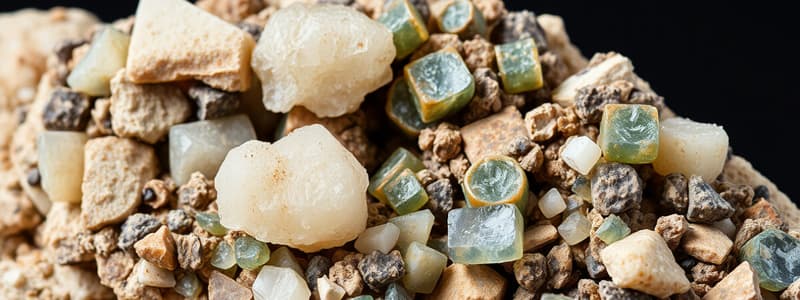Podcast
Questions and Answers
Which of the following minerals belongs to the silicate family?
Which of the following minerals belongs to the silicate family?
- Galena
- Calcite
- Gypsum
- Olivine (correct)
What type of ion do carbonates contain as their defining feature?
What type of ion do carbonates contain as their defining feature?
- Carbonate ion (CO3 2-) (correct)
- Sulfide ion (S2-)
- Sulfate ion (SO4 2-)
- Silicate ion (SiO4 4-)
Which mineral is primarily composed of a sulfate ion?
Which mineral is primarily composed of a sulfate ion?
- Smithsonite
- Hematite
- Gypsum (correct)
- Olivine
What are the common properties used to identify minerals?
What are the common properties used to identify minerals?
Which of the following statements correctly describes a characteristic of sulfides?
Which of the following statements correctly describes a characteristic of sulfides?
Which factors influence the economic viability of mining operations?
Which factors influence the economic viability of mining operations?
What type of properties are used to identify minerals apart from physical properties like luster?
What type of properties are used to identify minerals apart from physical properties like luster?
Which ore deposits are primarily formed through geologic processes such as cooling and crystallization?
Which ore deposits are primarily formed through geologic processes such as cooling and crystallization?
Which of the following best describes the role of water in mineral formation?
Which of the following best describes the role of water in mineral formation?
What mineral family is primarily comprised of iron, nickel, and cobalt?
What mineral family is primarily comprised of iron, nickel, and cobalt?
Flashcards are hidden until you start studying
Study Notes
Rock-Forming Minerals Overview
- Minerals are categorized into families based on their anion composition.
Silicates
- Most abundant mineral group in the Earth's crust.
- Key component: silicate ion (SiO4)4-, typically forms a tetrahedral structure.
- Common silicates include quartz (SiO2), K-feldspar (KAlSi3O8), olivine ((Mg, Fe)2SiO4), and kaolinite (Al2Si2O5(OH)4).
- Silicate tetrahedra can combine in various arrangements to form diverse minerals.
Carbonates
- Composed of cations and carbonate ion (CO3)2-.
- Notable examples include calcite (CaCO3), dolomite (CaMg(CO3)2), and siderite (FeCO3).
- Frequently found in limestone and marble, which are composed largely of calcite.
Oxides
- Formed from metallic cations combined with oxygen.
- Essential for various metal ores such as iron, chromium, and titanium.
Sulfides
- Minerals consisting of metallic cations bonded to sulfide ions (S2-).
- Important sources for copper, zinc, nickel, lead, and iron; notable examples are pyrite (FeS2) and galena (PbS).
Sulfates
- Composed of sulfate ions (SO4)2-.
- Common minerals include gypsum (CaSO4·H2O) and anhydrite (CaSO4).
Physical Properties of Minerals
- Hardness: measured using scratch tests.
- Cleavage: minerals break along flat surfaces based on crystal structure.
- Fracture: irregular breakage not along cleavage planes, such as conchoidal fractures.
- Luster: the way light interacts with a mineral’s surface (e.g., metallic, vitreous).
- Color: generally unreliable for identification; streak color provides more reliable information.
- Specific gravity and crystal habit/shapes vary among minerals.
Identification Techniques
- Chemical composition analysis using microprobes and chemical methods.
- Crystal structure analysis through X-ray diffraction.
- Physical properties assessment.
Special Properties of Minerals
- Certain minerals possess unique traits such as magnetism, fluorescence, and chemical reactivity.
Mineral Resources
- Building materials include stone, sand, gravel, and limestone.
- Non-metallic minerals encompass gypsum, coal, and various industrial minerals.
- Metallic minerals include non-ferrous and ferrous metals such as copper, gold, and iron.
Types of Ore Deposits
- Diverse origins include magmatic, pegmatite, hydrothermal, and sedimentary processes leading to different valuable minerals.
Economic Considerations in Mining
- Factors influencing mining economics include ore richness, quantity, extraction costs, and market prices of the extracted products.
Life Cycle of a Mine
- Phases of mining include exploration, development, active mining (with various processing stages), and eventual shut-down.
Issues and Challenges in Mineral Exploitation
- Questions surrounding mineral ownership and access to resources in unclaimed regions like the sea floor and Antarctica.
- Prospective consequences include environmental impacts such as pollution and mismanagement of natural resources.
Soil as a Resource
- Soil is a thin, crucial layer of the Earth's surface, important for sustaining life.
- Three primary soil types are classified as sand (gritty), silt (smooth), and clay (sticky and malleable).
Rock and Mineral Classification
- Rocks are characterized by visual and textural properties, including color, texture (proportion of sand, silt, clay), and hardness measurement through scratch tests.
Studying That Suits You
Use AI to generate personalized quizzes and flashcards to suit your learning preferences.




